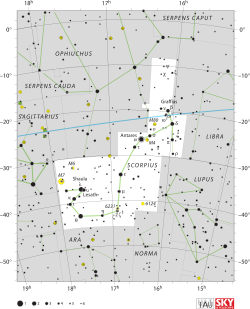V905 Scorpii
| V905 Scorpii | |
 | |
| Observationsdata Epok: J2000.0 | |
|---|---|
| Stjärnbild | Skorpionen |
| Rektascension | 17t 41m 59,025s[1] |
| Deklination | -33° 30′ 13,71″[1] |
| Skenbar magnitud () | 6,66[2] (6,3-6,9)[3] |
| Stjärntyp | |
| Spektraltyp | LBV,[3] A9 Ia[4] |
| U–B | +0,30[2] |
| B–V | +1,21[2] |
| Variabeltyp | Lysande blå variabel[3] |
| Astrometri | |
| Radialhastighet () | -35[5] km/s |
| Egenrörelse (µ) | RA: -1,75[1] mas/år Dek.: -1,49[1] mas/år |
| Parallax () | 0,54 ± 0,54[1] |
| Avstånd | ca 8 200 lå (2 500[6] pc) |
| Absolut magnitud () | -8,9[7] |
| Detaljer | |
| Massa | 13[7] M☉ |
| Radie | 150-330[3] R☉ |
| Luminositet | 290 000[6] L☉ |
| Temperatur | 8 000-12 000[3] K |
| Vinkelhastighet | 45[3] km/s |
| Andra beteckningar | |
| HD 160529, ALS 4332, CD-33 12361, CPD-33 4538, GSC 07380-00655, HIC 86624, HIP 86624, IRAS 17386-3328, LS 4332, 2MASS J17415902-3330136, PPM 296690, SAO 209151, TYC 7380-655-1, UCAC4 283-128659, uvby98 100160529, V905 Scorpii, Gaia DR3 4053887521876855808, Gaia DR2 4053887521876855808[8] | |
V905 Scorpii eller HD 160529 är en ensam stjärna i den mellersta delen av stjärnbilden Skorpionen. Den har en genomsnittlig skenbar magnitud av ca 6,66[2] och kräver åtminstone en handkikare eller ett mindre teleskop för att kunna observeras. Baserat på parallaxmätning inom Hipparcosuppdraget på ca 0,54 mas,[1] beräknas den befinna sig på ett avstånd på ca 8 200 ljusår (2 500 parsek)[6] från solen. Avståndet är dock osäkert och värden mellan 1,9 och 3,5 kpc har angetts.[3] Den rör sig närmare solen med en heliocentrisk radialhastighet på ca -35 km/s.[6]
Observation
[redigera | redigera wikitext]
V905 Scorpii har en säregen variabel spektraltyp med emissionslinjer och P Cygni-profiler. Vid visuellt maximum liknar den en A9-stjärna och åtminstone nära B8.[3] Baserat på ett avstånd på 2,5 kiloparsec varierar uppskattningen av radien från 150 solradier vid vila till 330 vid utbrott. Temperaturen varierar också, från 8 000 K i utbrott till 12 000 K i vila. Med dessa parametrar varierar den skenbara visuella magnituden med 0,5 och den bolometriska ljusstyrkan är konstant på 180 000 gånger solens.[3]

Uppskattningar av ytgravitationen leder till en massa på 13 solmassor och en trolig initial massa på 25 solmassor. Detta tyder på att V905 Scorpii är en före detta röd superjättestjärna.[7]
Referenser
[redigera | redigera wikitext]- Den här artikeln är helt eller delvis baserad på material från engelskspråkiga Wikipedia, V905 Scorpii, 17 januari 2024..
Noter
[redigera | redigera wikitext]- ^ [a b c d e f] Van Leeuwen, F. (2007). "Validation of the new Hipparcos reduction". Astronomy and Astrophysics. 474 (2): 653–664. arXiv:0708.1752. Bibcode:2007A&A...474..653V. doi:10.1051/0004-6361:20078357. S2CID 18759600.
- ^ [a b c d] Ducati, J. R. (2002). "VizieR Online Data Catalog: Catalogue of Stellar Photometry in Johnson's 11-color system". CDS/ADC Collection of Electronic Catalogues. 2237: 0. Bibcode:2002yCat.2237....0D.
- ^ [a b c d e f g h i] Stahl, O.; Gäng, T.; Sterken, C.; Kaufer, A.; Rivinius, T.; Szeifert, T.; Wolf, B. (March 2003). "Long-term spectroscopic monitoring of the Luminous Blue Variable HD 160529". Astronomy and Astrophysics. 400: 279–291. arXiv:astro-ph/0212473. Bibcode:2003A&A...400..279S. doi:10.1051/0004-6361:20021908. S2CID 15409946.
- ^ https://www.universeguide.com/star/86624/hd160529. Hämtad 2024-03-25.
- ^ Gontcharov, G. A. (2006). "Pulkovo Compilation of Radial Velocities for 35 495 Hipparcos stars in a common system". Astronomy Letters. 32 (11): 759–771. arXiv:1606.08053. Bibcode:2006AstL...32..759G. doi:10.1134/S1063773706110065. S2CID 119231169.
- ^ [a b c d] Nazé, Y.; Rauw, G.; Hutsemékers, D. (2012). "The first X-ray survey of Galactic luminous blue variables". Astronomy & Astrophysics. 538: A47. arXiv:1111.6375. Bibcode:2012A&A...538A..47N. doi:10.1051/0004-6361/201118040. S2CID 43688343.
- ^ [a b c] Sterken, C.; Gosset, E.; Juttner, A.; Stahl, O.; Wolf, B.; Axer, M. (July 1991). "HD 160529 – a New Galactic Luminous Blue Variable". Astronomy and Astrophysics. 247 (2): 383. Bibcode:1991A&A...247..383S.
- ^ V905 Sco (unistra.fr). Hämtad 2024-03-25.
- ^ Sterken, C.; van Genderen, A. M.; de Groot, M. (January 1997). "Cyclic Light Variations in LBVs". Astronomical Society of the Pacific Conference Series. 120 (Luminous Blue Variables: Massive Stars in Transition): 35. Bibcode:1997ASPC..120...35S. Hämtad 16 mars 2022.
- ^ "ASAS All Star Catalogue". The All Sky Automated Survey. Hämtad 8 december 2021.
Externa länkar
[redigera | redigera wikitext]Text is available under the CC BY-SA 4.0 license; additional terms may apply.
Images, videos and audio are available under their respective licenses.





